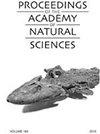Second species of Langlieria (Tristichopteridae, Sarcopterygii) from the Upper Devonian Catskill Formation of Pennsylvania, U.S.A., and a new phylogenetic consideration of Tristichopteridae
IF 0.5
4区 环境科学与生态学
Q4 BIODIVERSITY CONSERVATION
Proceedings of the Academy of Natural Sciences of Philadelphia
Pub Date : 2022-04-22
DOI:10.1635/053.167.0115
引用次数: 1
Abstract
ABSTRACT. A new species of Langlieria is described from the Upper Devonian (Frasnian) Irish Valley Member of the Catskill Formation. The type material was collected from a road cut exposure on the north side of the westbound lanes of Pennsylvania Route 322 west of Port Matilda, Centre County, Pennsylvania, U.S.A. The new species of Langlieria, the second from the Catskill Formation, is represented by high quality cranial material including parietal and postparietal shields, cheek, principal gular, and lower jaw; fin material; and body scales. The new species is the fourth tristichopterid to be described from the Catskill Formation (after Hyneria lindae, Langlieria radiatus, and Eusthenodon bourdoni) and the first from the Irish Valley Member. It is also the first species of Langlieria with a known record in the Frasnian. Sedimentological and stratigraphic data suggest that the discovery site represents a distal, tide-dominated location within the Catskill Delta system with a greater marine influence than has been reconstructed for the previously described Catskill Formation tristichopterids. A new phylogenetic analysis of Tristichopteridae is presented that is the first to include the new species of Langlieria described here and E. bourdoni from the Cogan House Exit Ramp locality (Famennian, Duncannon Member) along U.S. Route 15/Interstate 99. The 50% majority-rule consensus tree from the analysis supports a highly-nested clade of tristichopterids that includes all of the considered species from the Famennian, with the exception of Heddleichthys dalgleisiensis, and additionally includes the Frasnian Langlieria species that is described here.美国宾夕法尼亚州上泥盆纪Catskill组Langlieria的第二种(三足目,Sarcopterygii)和三足目的一个新的系统发育考虑
摘要从卡茨基尔组的上泥盆世(弗拉斯纪)爱尔兰谷成员描述了一种新的Langlieria。该类型材料采集于美国宾夕法尼亚州中心县Port Matilda以西宾夕法尼亚322号公路西行车道北侧的路堑暴露处。Langlieria新种是来自卡茨基尔组的第二种新种,以高质量的颅骨材料为代表,包括顶骨和顶骨后盾、脸颊、主颚和下颌;翅片材料;还有身体尺度。这一新物种是在卡茨基尔组(Catskill Formation)中发现的第四种三爪龙(继Hyneria lindae、Langlieria radiatus和Eusthenodon bourdoni之后),也是在爱尔兰谷(Irish Valley)地区发现的第一种。它也是第一个在弗拉斯尼亚有已知记录的Langlieria物种。沉积学和地层学数据表明,该发现地点代表了卡茨基尔三角洲系统中一个远端,潮汐主导的位置,与之前描述的卡茨基尔组三翼龙相比,海洋的影响更大。本文提出了一种新的三爪虫科系统发育分析方法,首次纳入了本文描述的Langlieria新种和美国15号公路/ 99号州际公路沿线Cogan House Exit Ramp地区(famenian, Duncannon成员)的E. bourdoni新种。从分析中得出的50%多数规则共识树支持一个高度嵌套的三爪类分支,它包括了除Heddleichthys dalleisiensis外的所有被考虑的famenian物种,此外还包括了这里描述的Frasnian Langlieria物种。
本文章由计算机程序翻译,如有差异,请以英文原文为准。
求助全文
约1分钟内获得全文
求助全文
来源期刊

Proceedings of the Academy of Natural Sciences of Philadelphia
生物多样性保护-生物多样性保护
自引率
0.00%
发文量
4
期刊介绍:
The Proceedings (ISSN 0097-3157) has been published continuously since 1841. Many volumes are still available in their original printings. Early volumes are unbound, constituting two or three issues per year. Quantities of some volumes may be limited. Early volumes may have slightly soiled cover sheets, but the text blocks are perfect.
 求助内容:
求助内容: 应助结果提醒方式:
应助结果提醒方式:


